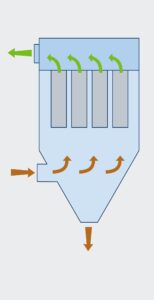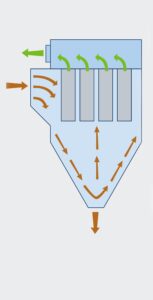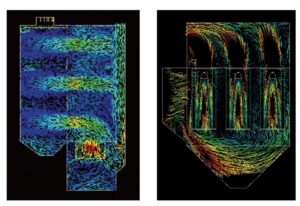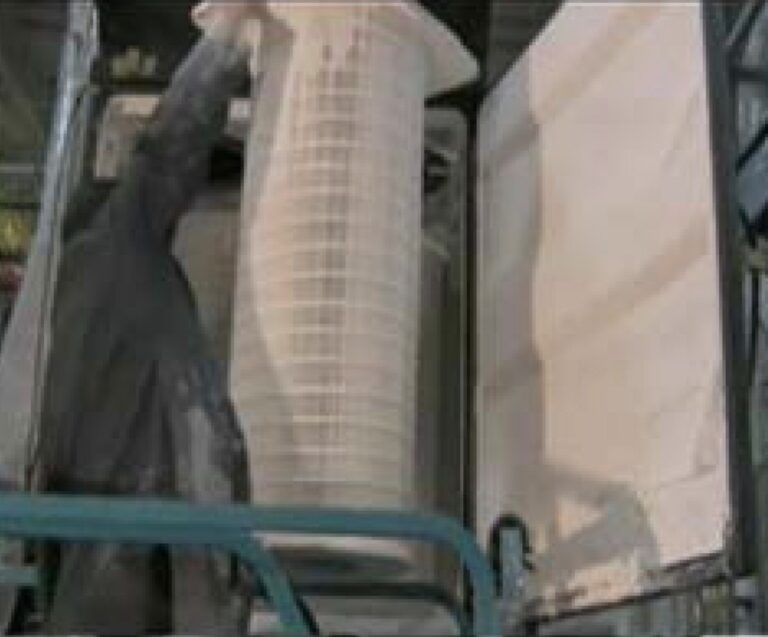A Case for Downflow Cartridge Collection
Research has shown that superior performance results from the downward flow of the dirty airstream
By John Woolever, Donaldson Torit Product Manager
Downflow vs Other Designs
Dust collection using pleated media filter elements known as cartridges has become a ubiquitous solution for industrial ventilation requirements in recent decades. Cartridge dust collection equipment can be grouped into two categories based on cartridge orientation and the cabinet’s airflow design:
1) A downflow collector design with cartridge filters positioned horizontally and the dirty air inlet positioned above all filtration media and
2) Crossflow or upflow collector designs with cartridge filters hung vertically and the dirty air inlet positioned below or at the side of the filtration media.
Some in the industrial ventilation marketplace make claims that a collector with vertically-hung cartridges is superior; they cite anecdotal examples without supporting data. However, credible facts support the advantages of a downflow collector design, including the American Conference of Governmental Industrial Hygienists (ACGIH®) Industrial Ventilation Manual:
Section 8.3.2 of Industrial Ventilation Manual states, EPA-Sponsored¹ research has shown that superior performance results from the downward flow of the dirty airstream. This downward flow reduces re-deposition since it aids gravity in moving dust particles toward the hopper.
Before reviewing other factors on this subject, a brief review of the origins of cartridge collection is beneficial.
In the 1970’s, cartridge collectors were originally designed to replicate baghouse dust collectors that contained vertically-hung, cloth filter bags with dirty air entering the collector below the filters. (See image A.) The pleated media of a cartridge filter element provided superior filtration efficiency and reduced emissions over a comparable bag fabric. However, the new style dust collector still had many of the same limitations of its baghouse predecessor including:
- Dust discharged from cleaned cartridge filters still needed to fight past incoming air before settling in the hopper/containment vessel. This led to dust re-entrainment on the filter media surface, with higher net operational pressure drop and shorter filter life.
- Filter change-out activities remained time-consuming, dirty, and generally unpleasant because servicing the filters still required an operator to open the dirty air plenum via a large access door.
A) Upflow Vertical Cartridge B) Cross-flow Vertical Cartridge C) Original Downflow Cartridge D) Evolved Downflow Cartridge with inlet to drop-out zone




Design Improvements
Design improvements to the vertically-hung collector design were realized over the years with the inclusion of side inlets (that allowed the operator to enter the collector next to filtration media instead of below it). This led to some reduction of dust re-entrainment. However, cleaned dust particles were still impacted by incoming air, and cartridge change processes still exposed operators and the dust collector surroundings to a large opening to the dirty air plenum. (See image B.)
Finally in the 1980’s, a breakthrough was achieved by rotating the filter cartridge orientation from vertical to horizontal and by positioning the dirty air inlet above all filtration media. This change resulted in an incoming air flow pattern aligned with the desired final location of the dust discharged from the cleaned filter cartridges. Since gravity naturally directs discharged dust particles down towards the containment vessel located at the bottom of the collector, the incoming air pattern of a downflow collector could now assist the movement of particles to the storage vessel at the base of the unit, rather than fight against it. (See image C.)
This improved airflow management design reduced dust re-entrainment, which could be enhanced further by using filter cartridges containing surfacing-loading fine fiber filtration media. Reductions in dust re-entrainment can lower operational pressure drop, extend filter life, and reduce compressed air consumption used for pulse cleaning filter elements — all of which benefit the dust collector’s operational expense and improve the total cost of ownership for the collector.

Advanced airflow analysis methods have allowed further improvements in downflow collector designs. Optimizing the cartridge-to-cartridge spacing and the cartridge-to-cabinet wall dimension allows for greater air filtering capacity for a given collector housing size. The example analysis to the right compares the results of sophisticated airflow management designs for a downflow and side entry collector. The downflow collector on the left shows lower velocities in the dirty air plenum, which allows dust particles to drop out of the airstream more effectively. In contrast, the vertically-hung collector to the right shows higher velocities as well as upward “sweeping” patterns in the hopper section, which impacts how cleaned dust particles settle into the containment vessel under the hopper.
Even more gains are possible with new approaches to positioning dirty air entry for low-loss pre-separation. Recent design advancements show airflow capacity is increased when the dirty air inlet is positioned in a downflow orientation away from filtration media. This dropout zone allows heavy particulate to fall from the airstream without touching filtration media and also allows for even distribution of the airflow, eliminating of high velocity “hotspots” that can prematurely wear filter media. (See image D.)
Some collector manufacturers point to anecdotal images of horizontal filters with dust build up and bridging across the top surfaces of filter elements. In reality, properly designed, operated, and maintained downflow collectors have reverse pulse cleaning systems that limit this dust build-up on filtration media surfaces. A knowledgeable cartridge collector supplier should be able to provide comprehensive pulse signature data quantifying the cleaning energy delivered to the filtration media.
Pulse Cleaning
Recently, a significant breakthrough in pulse cleaning technology was introduced to the marketplace and is currently only available in a downflow cartridge configuration. With a design that controls the pulse cleaning system’s compressed air expansion and minimization of energy delivery losses, the new cleaning system is proven to deliver 27% higher impulse cleaning energy. Increased cleaning energy can increase filtration capacity and lower compressed air energy consumption.
Better Air-to-Media Ratios
When superior airflow management design, effective pulse cleaning performance, and surface loading fine fiber filtration media are brought together in a single package, a downflow dust collector can have impressive air filtering capacity benefits. One way to evaluate a collector’s airflow capacity is by comparing volumetric airflow rates against filtration media area. This air-to-media ratio (AMR) or filtration velocity is typically used to size equipment for given applications.
Smaller Footprint
Beyond dust collector performance and capacity, scalability and configurability are two additional advantages downflow collectors have over vertically-hung collectors. A downflow collector’s horizontal filter orientation allows cartridges to be positioned in a matrix that can increase in height as well as width for greater flexibility and reductions in total footprint on the shop floor. Vertically-hung collectors have only one layer of filters, so increases in filtration media area require increases in width and depth because height is fixed. This often results in a larger total footprint for an increased air handling capacity.


Better Explosion Venting Positioning
Explosion venting is another area where downflow collectors are different than vertical element collectors. Explosion relief vents can be located on the roof or the side of a downflow collector with no change in equipment footprint. Because explosion vents must be located on the side of vertically-hung collectors, they typically require an extended footprint in order to direct vents upward. Many facilities prefer upward or roof-mounted explosion vents because the deflagration flame front and the materials discharged during a deflagration event are both directed upward where there is reduced exposure to occupied areas.
Easier Filter Changouts
Finally, the filter change process in a downflow collector simplifies element replacement and helps minimizes operator exposure to collected contaminates compared to the older, vertically-hung collector design. The downflow collector typically has covers that provide access to just a few cartridges at a time. This can be a great advantage if the collector is located outdoors in potentially windy locations. The old-style, vertically-hung collectors typically require larger access doors that expose the operator and surrounding area to the entire dirty air plenum. Downflow style collector’s horizontal cartridge removal is also simpler and cleaner, requiring the operator to place only his/her arm into the collector to reach cartridge filters. Vertically-hung collectors either require special tools to reach into the cavernous dirty air plenum, or actual physical entry (potentially confined space entry) by the operator to access cartridge filters deeper in the cabinet structure. While nearly all dust collector designs accommodate industrial platforms for filter access, downflow collectors can also be accessed by a step ladder to help reduce the impact on the shop floor area.
Because of the larger door and more difficult access to cartridge filters, as well as the typically larger/heavier filters, the filter replacement on vertically-hung collectors typically requires a platform, a man-lift, or some other kind of elaborate access.
Summary
More than 40 years after its inception, cartridge collectors continue to be a compelling and economical solution for facility operators in many different industries. Downflow style collectors deliver reduced dust re-entrainment, minimized footprint, greater configuration flexibility, and superior filter change experiences. With these user benefits, the case for downflow cartridge collection is clear.

AST Canada has been helping clients find solutions for their unique Dust, Mist & Fume Collection needs for more than 40 years.
We can help you too.
